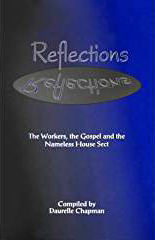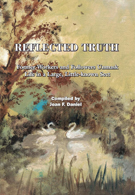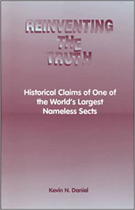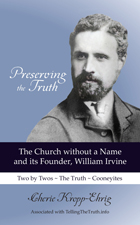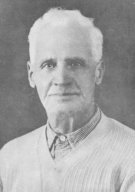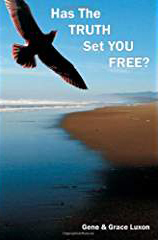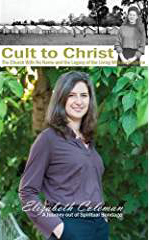The Journal of John Long
YEARS:
Preface
1872-1889
1890
1895
1896
1897
1898
1899
1900
1901
1902
1903
1904
1905
1906
1907
1908
1909
1910
1911
1912
1913
1914
1915
1916
1917
1918
1919
1920
1921
1922
1923
1924
1925
1926
1927
1897-1898 "Revival Years" Revised Version
About John Long
Finding John Long's Journal
Significance of John Long's Journal
Treatises and Writings by John Long
Inspirational Poetry by John Long
Photos of the John Long Family
NOTE: For the sake of brevity, John Long will sometimes be referred
to as Long and Wm. Irvine as Wm.I.
FM stands for Faith Mission.
I have referred to the workers as Go Preachers, as this is how John Long
refers to them.
The name Go Preacher came about from the words "As
ye go preach."
* * * * *
THE WAY THEY WERE… John Long was a Go Preacher for ten years – from January, 1897 to 1907--until the group became too exclusive for him. When Irvine made it mandatory that the workers believe and preach that all clergymen outside their group were unsaved, a belief which John Long could not accept, Irvine forced John to leave the Go Preachers.
John Long was the one who, along with Wm. Irvine:
“…being the two instruments used of God at the origin of that movement.”
(June, 1907)
“…namely the right of fellowship in the Mission I helped to start.”
(June, 1907)
“…having to leave the Go Preacher fellowship; which God used me
so much in, FROM ITS BEGINNING, ten years ago."
(June, 1907)
Since John Long was forced out of the Go Preachers when they changed their belief system to be exclusive or sectarian, as he calls it, it is not surprising that his Journal for this ten-year span traces in detail the changes in the group’s perspective in this particular area. He clearly shows their beliefs in the beginning, where their converts were won to Christ and then left with “the option of their own will as to where they worship and get the most spiritual food.” In other words, the new converts were left to attend the church of their own choice. Separation from other Christians was not a part of their teaching. They did not set up meetings in the homes, did not RE-baptize, or keep themselves separate. When the Go Preachers began to “unchristianize the Christians” outside their group, this troubled John Long very much, as it went against his beliefs.
There are many details found in this Journal that were helpful and informative;
and some information provided verification and fuller details for things
reported previously:
1. We learn the background and personal history of John Long.
2. We learn who John Long really was; and his relationship to the Go
Preacher Movement.
3. We learn what a Methodist Colporteur was and did.
4. We learn about John Long’s first contact with Wm. Irvine in February,
1897.
5. We learned that Wm.I attended the Bible Institute for two years.
6. We learn about Irvine’s “Call to Service:” The scripture that underwrote his actions all his life—his role as The Thresher. “Behold I will make thee a new sharp threshing instrument having teeth, thou shalt thresh the mountains, and beat them small, and shall make the hills as dust,” Isaiah 41:15.
7. We learn about the FIRST REVIVAL, which was in a Mission held in Nenagh (Ireland) in August, 1897. In time, this Mission was referred to as The Inception of the Go Preacher Movement. The first person to be saved was the Protestant School Mistress, Sister Oakley, followed by thirty plus persons; and most of them afterwards gave up all that they had to become Go Preachers, including Jack Carroll and his sister May. The Nenagh Revival was held by John Long and Wm. Irvine, while John Long was a Methodist Colporteur and Irvine was a Faith Mission pilgrim, and their converts came to Christ under the umbrella of the Faith Mission. [FM Reports verify their success]
8. We learn about the SECOND REVIVAL in September, 1897, which was a Mission held at Rathmolyon, Co. Meath, Ireland, where forty persons were converted; and most of them went on to become Go Preachers. There were subsequent Revivals also in other locations.
9. We learn that it wasn’t until July, 1898, a year later and also many converts later, AFTER the Revival missions took place that Irvine and Long studied Matthew Ten. We learn what their original thoughts were re: Matt. 10; which they called going on “Faith Lines.” Long wrote: “While in Kilkee we had a Bible reading on Matthew 10. It was that Bible reading set me first thinking about going on Faith Lines.”
10. We learn exactly what “Faith Lines” according to Matt. 10 meant to Long and Wm.I at that time. It was NOT what the 2x2 workers today mean when they say they “go in faith.” It was NOT going in pairs, celibate, unmarried and meeting in homes. Long: “Faith Lines is a preacher going forth without any fixed or stated salary, neither any public collections at meetings, but just trusting in God to put it into the hearts of God's people to give to the support of them who ministered in Spiritual things. If more came in than necessary learning to abound, if less learning to suffer lack.”
11. We received confirmation of the reported experimental bicycle trip made in October, 1899 by several young Irish men (converts) to prove whether or not Faith Lines per Matthew Ten would work in this day and time. Long wrote: “After the convention William Irvine invited me over to his sisters home in Queenzieburn, Kilsyth. At the same time, he went to meet some young men that came over from Ireland, with the intention of going fully on the Lord’s work.” [Note: this was a Faith Mission Convention]
12. We learn that in 1898, in Galway town, Long and Tom Turner "tried to sell the Scriptures but the people would not buy. One day we left our books at home and took a Matthew 10 tour into the country going to the homes with the salutation 'Peace be unto this house' ...and the 'Kingdom of God is come unto you.'
THE FORMATIVE YEARS – 1897 – 1903…………………Their Sojourn in Egypt
13. We get a glimpse into the first six (6) formative years of the group (years 1897–1903), where they were scattered, groping their way and floundering without organization or a strong leader per se. Each preacher was more or less on their own, left to the Spirit to guide them. Long: Their “young converts began to hold missions…Some joined the Faith Mission, others joined Todd’s Mission in the Southeast of Ireland, and others went out not connected with any mission…” The converts of the preachers were left “the option of their own will as to where they worship and get the most spiritual food.”
14. We learn that at first, in their formative years, the Go Preachers and Faith Mission workers were strictly Evangelists or Revivalists—without a church, just as the FM workers were. They were truly NOT a sect or church—they were UNSECTARIAN. While we were aware that in their Early Days, there were only preachers (no saints or laity class)—we assumed that their converts sat at home on Sundays—and NEVER would we have guessed that the Go Preachers happily sent them off to worship and break bread with other Christians at the local church of their choice. However, this practice would cease a few years after their inception.
15. We learn that wherever the Go Preachers were on Sunday, that they met with other Christians in their various churches or places of worship and broke bread (Lord’s Supper) with them. Long was offended whenever a Christian group proved to be exclusive and would not allow him to break bread with them, and he recorded this in his Journal when it occurred. [If you’re wondering if Long and others new converts allowed other Christians to break bread with them--remember, they had no meetings then! They were not a sect.][It would not be long before the Go Preacher movement would serve the Lord’s Supper in their Sunday meetings and not allow outsiders to share it with them]
16. We learn that some of the workers practiced divine healing, laying on of hands and dedicated babies. They worked odd jobs when they needed money.
17. We learn that at the early conventions and meetings in their formative years, they invited preachers from other denominations to preach to them. The Go Preachers also preached wherever they were invited or could get an opening in other churches
18. We learn how Long’s financial needs were met—in detail, and presumably other Go Preachers’ needs were met in similar manner. They accepted all offers of financial help, regardless of the religious background or affiliation of the person offering. John Long takes great pains to give credit in his Journal to those who assisted him financially. At times, they even put a box outside their wooden halls to receive gifts! "By experience we learned that it was not inconsistent with Faith Lines to have a box at the door of our tent for free will offerings; so as that the poor widow could give her mite, as well as the rich their abundance. 'But Jehoiada the priest took a chest, and bored a hole in the lid of it, and set it beside the altar on the right side, as one cometh into the house of the Lord,' 2 Kings 12:9. Nearly all Christians are agreed that this should be the case on the Lord’s day, 1 Cor. 16:1-2. During that campaign in Scotland, we did so; and sufficient was put in it to pay our expenses." [This practice would change to where they would only accept donations from their own converts, and only those in good standing, and it is this way today. They also harshly condemn collection plates and boxes and asking for donations in any manner.]
19. We learn about the different methods they used in their ministry back then. Long wrote: "Besides our nightly meetings that constituted a mission, I occasionally took mothers’ meetings, Bible classes, children’s meetings; also did a measure of street preaching, house to house visitation, personal dealing and tract distribution. In the churches of all protestant denominations, in Mission halls, tents, barns, cottages, School Rooms, public halls, Etc....regarding the extraordinary sessions of house to house visitation and personal conversations…House to house visitation consisted of two sorts. 1st Direct visits to homes accessible where they receive inside so as to read the Scriptures and pray with the inmates 2nd Calling at the doors and speaking to persons about their souls salvation also giving them pure gospel tracts, periodicals and pamphlets and inviting them to come to meetings."
20. The Journal gives the principals of the doctrine of Christ as taught by Wm. Irvine; and tells how he conducted his meetings; also Irvine’s practices, including healing. His doctrines were also the FM doctrines, and Long pronounced them “sound.”
21. We get an inside view of Long’s struggle to decide whether or not resign as Colporteur and go preach solely on Faith Lines…Wm.I wanted Long to join the Faith Mission, but Long decided this wasn’t God’s will for him, and went out on his own in January, 1899. [It wasn’t until 1901 that he is listed as going into the work on the 1905 Workers List.]
22. We learn that it was John Long who became the FIRST to go preach solely on Faith Lines according to Matthew Ten. He and Irvine made this Bible Study in July, 1898. JL resigned from the Colportage work shortly after, in Nov. 1898. [Irvine claimed in a letter that he was kicked out of the FM in Sept, 1898; however, Wm. Irvine did NOT immediately resign from the Faith Mission and go on Faith Lines for (3) more years, until sometime early in 1901.]
23. We learn details concerning the opposition they encountered, which was why they built moveable wooden halls or baches. Long wrote: "Because of the difficulty in getting halls and churches for Missions, Jack Carroll organised the building of a Wooden Hall, and in one year there were at least dozen built in the British Isles…They were a splendid invention to preach the gospel in districts where it was hard to get Mission halls or houses, Etc.”
24. We learn the names of other workers/converts who joined them…Thomas Turner, Ben Boles, a shopkeeper from Roscrea; John Sullivan, a School Master from Moneygall; Irvine Weir, Albert Quinn both from Dublin; Tom Hastings from Rathmoylon and John Hardie, a Scotsman; George Walker from Dublin; Andrew Robb, Thomas Craig, William Clelland, Joseph Kerr, Richard Meikle.
25. We learn that the Go Preachers, Wm. Irvine included, participated enthusiastically in distributing Christian books, tracts and literature. “There was much use made of Bibles, Testaments, texts, tracts, periodicals such as Bright Words. William Irvine took a special interest in circulating Andrew Murray’s books, such as "Abide in Christ," "The New Life," "The Ministry of Intercession" etc. [They would later eschew all Christian literature besides the Bible, their own hymnal, and a basic concordance.]
26. We received confirmation and additional details about Edward Cooney becoming associated with them in 1901.
27. We learn of a meeting Cooney convened in 1901 where there was much confusion among workers. Wm.I refused to attend. Long wrote: “The cause of the confusion and disorder arose from about twelve workers, mostly women, who were out preaching and used in getting other persons saved; yet got an experience in which they denied their first conversion…They were inclined to 'unChristianize' others who had not a similar experience; and put down the revival that gave them birth…They were very sanctimonious…They refused to take any correction.” [Obviously most of the workers there did not agree that to be saved, a convert must deny their earlier conversion; and certainly Long did not agree.]
28. We learn that Edward Cooney began to baptize his converts and form assemblies (churches in the homes) in July, 1902. [This is earlier than we had thought. Before reading Long’s Journal, we had deduced that house churches were not started until 1906-1908]
29. We learn about the events that led up to Wm.I leaving FM; and Wm.I’s agonies over leaving FM and going solely on Faith lines, which he did in 1901. At this time, others looked to Wm.I as the leader of the group. He directed things, and sent workers to and fro in the United Kingdom, to be companions with other workers; kept the wooden halls in use. [Interesting that Wm.I went on Faith Lines about the same time as Cooney joined them, and the same time John Long is shown as “entering the work” on the 1905 Workers list. Cooney was a great advocate of Faith Lines.]
30. We learn of the dissatisfaction of Wm.I in April, 1903, with the way things were going or turning out. Wm.I paid Long a visit, to get his advice as to whether he should abandon the group as leader and just “labour for God independently in a new district; as he shrank back from forming a new mission or sect; and the work and workers at that time were very scattered and disorganized.” John Long urged him to get things organized; to call a convention; and “get the workers united together; and form the young converts into assemblies where they could get spiritual food, but to be open and unsectarian in attitude towards all other sects, missions and persons.” This visit had far reaching effects and became the catalyst to the group organizing in the near future.
THE ORGANIZATION IS BORN…………..
31. We learn that just three months later, Irvine called 70 workers to an ORGANIZATIONAL Convention held in Rathmolyon, Ireland on Willie Gill’s farm in July, 1903. Long wrote: “The workers began to baptize, and separate their converts; to form them into assemblies to meet together on the first day of the week for fellowship, breaking of bread and prayers. Also, they appointed bishops, or elders over them. William Irvine emphasized separation but not exclusiveness. It was from that conference a few workers including William Irvine, went to America for a gospel tour.” The group came together as a cohesive body, establishing policies and regulations. They became organized and left behind their formative years.
32. We learned some about the FIRST Crocknacrieve, Convention held for converts in Sept. 1904, on John West's Farm. “There were no appeals for money; and no public collections; the strength and fruits of the teaching produced the necessary money which was given freely to defray the expenses which amounted to nearly fifteen hundred pounds; including the passages of those who went foreign; gave much preeminence to reading the Bible; and circulating them; and every worker was prone to spend much time in private prayer. Flirting or courting was not allowed; and the flesh or selfish life strongly condemned. Marriage was not forbidden; yet the unmarried life was commended as the freest for workers. The necessity of keeping prophets chambers and entertaining strangers was strongly set forth. At the close of the conference, every worker threw his or her money into one common purse; then it was equally divided on departing to the varied districts and fields of labour. At that convention Irvine warned the workers of speaking against men of God, such as J. G. Govan. Edward Cooney who was in great form tested the meetings every night; when the unsaved came in; and a gospel effort was made to win them. Those efforts were very fruitful for upwards of one hundred-some decided for Christ; and about the same number were baptized by immersion in a river near by.”
33. We learn of misunderstandings between Long and Irvine, usually when Long objected or refused to take orders from Irvine. Long held tightly to his right to allow God to direct him without a middle man, and was hurt when Irvine didn’t respect this right.
THE WAY NARROWS…………………..THEY BECOME THE ONLY RIGHT WAY
34. We learn some of the background of Joe Kerr.
35. The Journal gives details (not previously known) as to the catalyst
concerning their change in belief in 1905 to where they believed no other
preachers were saved. “Joseph Kerr, one of the most gifted
and talented of the workers…attended a conference, in the Bridge of Allan
in Scotland; and he was so disgusted with the way the Clergy preached;
that he come to the conclusion that there are no clergymen saved.
Without any charitable consideration of the conscience or opinion of others,
he preached it at that convention. Irvine defended him, but Edward
Cooney opposed him and tried to prove that John Wesley was a born again
man.” Joe Kerr was 24 years old at this time.
36. We learn that: “The definite article used in such a narrow way as THE truth, THE way, THE testimony, Etc. unto the exclusion of all other sects and missions outside their own became at that time very common. They “unChristianized” all Christians outside themselves; and refused fellowship with them, and I could not go that length conscientiously.”
37. We read about Wm.I’s growing severity and discipline on his workers; the spirit of a ruler arising in him; exercising his power, his rebuking Long; his being displeased and making public examples of one for the others’ sake; starting to fully act out his role as “The Thresher.” [See note at end on this subject]
38. We learn that it was at the July, 1906 Crocknacrieve convention that “Edward Cooney emphasized RE-baptism into their fellowship; which was the beginning of refusing fellowship with Christians of all other denominations; and raising a sectarian barrier which made their fellowship exclusive and sectarian; that I could not receive without a struggle…In many ways Irvine was a compassionate and kind man, even though severe at times. He took up the most faithful worker and thrashed him before the rest for an example; and that accounted for his severity to me.”
39. We learned more about Wm.I’s intolerant stance in 1906 against the clergy: “every where he went he preached that the clergy were unsaved men going to Hell. He believed that it would be iniquity to believe a thing and not preach it; or to preach it in one place and not in another; that only made him the more faithful in his error; and the less open to take correction from any well wishing servant of the Lord.”
40. We learn more details concerning Long leaving the Go Preacher fellowship in June, 1907 “which God used me so much in, FROM ITS BEGINNING, ten years ago…I have no doubt that God used William Irvine to witness against clericalism; but in doing so he ran into the opposite, in going beyond truth when he preached that every clergyman is a false prophet and unsaved. Because I tried to correct him, and did not accept all he said as truth, I became unpopular among the workers.
41. It is interesting that John Long never mentions a church building structure in a negative light; nor does he use the term “false church.” [Commonly used term by current 2x2s]
AFTERWARDS…………..
42. We learn more details of Long through the year 1927, AFTER he left the Go-Preachers—when he was still preaching the Gospel, “and fully in the Lord’s work and a Go-Preacher, though not in fellowship with them.”
43. The Journal corroborates much history contained in Goodhand Pattison’s Account of the Early Days.
AUTHOR's COMMENTS:
Today, the act of Wm. Irvine in starting the Go Preacher movement is often explained with, “He received a revelation from God.” Supposedly this revelation came from Matthew 10 and involved God wanting itinerant, homeless, poor, unmarried, celibate, 2x2 ministers; and saints that meet in churches in the homes, not buildings. John Long’s Journal disproves this theory. It shows exactly what Matthew 10 meant for them in that day and time. It shows them experimentally proving it for a time. John Long explains it well throughout his diary, calling it “Faith Lines.” Their belief system truly evolved over time to become what it is today. There was no complete comprehensive revelation given anyone of the 2x2 belief system. It was trial and error; confusion at times; there were changes, improvements, reform, struggles, additions—over time. They truly groped their way, as Ed Cooney wrote. The Journal also dispels any possible notion that the Go Preachers were of apostolic succession. It was NOT REVEALED—IT TRULY EVOLVED. And thanks to John Long, his Journal clearly shows this.
The Journal tells of the passage of scripture that Wm. Irvine took as his “call to service” (Is. 41:15-16). He believed he was to be The Thresher, with teeth which God made to thresh the mountains and beat them small.” We learn from the Journal that Wm. Irvine applied himself in this role towards the clergy and clericalism with a vengeance, speaking out very vocally against them—until he eventually declared that no clergymen were saved; no, none were even good men. (never mind that Wm.I was saved through Rev. John McNeill!) After reading John Long’s Journal, the author believes that there is a possibility that Wm. Irvine had a predisposition to judgment and condemnation, which was confirmed to him by the scripture he took as his “call to service.” Even though he had enough positive experience in the Bible Institute to give his life to the Lord’s work via the Faith Mission, his predispositions grew to a point where he would soon condemn all others, save those who believed his ideas.
This spirit is alive and well in those in the 2x2 fellowship today, who take license to put down, ridicule, mock and disparage outside pastors, priests, evangelists, Christians, other churches, their good works and missionary work. Both the laity and preachers do this without giving a thought to it. Those born and raised in the group have heard it all their life, and for them it is the “norm.” It has been passed down from generation to generation and is still being passed on today through its members. Many have never stopped to think about it; what it really means, or the repercussions. The author believes the present day spirit of judgment and condemnation found in the group is directly linked to its Father, Wm. Irvine, and his severe disparagement of all Christendom, outside of his ideas. And that this is due to the role he assumed as God’s threshing instrument, which he erroneously believed God appointed to him.
There are at least three copies of John Long's journal. The original and two copies. In 1920, John Long finished his Journal and made a copy of it for his son. He left the original with a friend in April, 1923. Then he copied another Journal for his other son from the copy he retained. In the preface of the last Journal copy, there is a notation that it contains additional information that he added as it came to his mind while copying from the other Journal. Therefore, the Journals are not identical.

 REPRESENTING THE LARGEST COLLECTION OF 2X2 HISTORICAL DOCUMENTS ON THE INTERNET
REPRESENTING THE LARGEST COLLECTION OF 2X2 HISTORICAL DOCUMENTS ON THE INTERNET
 Perry, Oklahoma Conv, 1942
Perry, Oklahoma Conv, 1942
